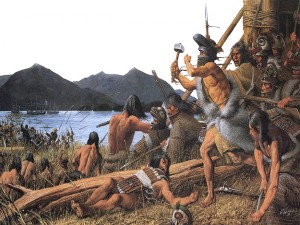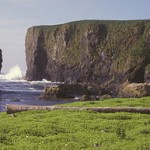As global population grows at a startling rate, global emissions of greenhouse gasses and demand for more reliable sources of food grow in parallel. These issues are slowly becoming ones that urgently need to be addressed. Gradually, more and more individuals are trying innovate new ways curb anthropogenic greenhouse emissions and cope with the growing global demand of food. Engineers are developing cleaner sources of energy and international politicians are trying to implement legislation that limits emissions. More recently however, archaeologists concerned with preservation and sustainability are rediscovering land management techniques used by ancient civilizations that could be replicated in a modern fashion with enormous payoff.
During her work in deep within the Amazonian rainforest, Crystal McMichael, an archaeologist/paleoecologist at the Florida Institute of Technology, mapped a large collection of soil deposits classified as terra preta or “black earth”. These deposits of darker soil are drastically different than the soil surrounding it. Typically, Amazonian soil is of rather poor quality because the biodiversity of the rainforest promptly extracts any extra nutrients. It would be almost impossible to maintain a civilization on this type of soil. However, the terra preta found in many sites had a considerably larger nutrient count and was much more suitable for agriculture. McMichael’s team located several terra preta deposit sites in Amazonia and found that a majority of sites of enriched soil were located in eastern Amazonia on top of bluffs overlooking the Atlantic Ocean. Typically, these bluffs were eroded of the porous Amazonian soil and were practically bare and infertile. However, after the terra preta was introduced, there’s evidence that these bluffs could have sustained huge swaths of agriculture. From a purely archaeological standpoint, this data is useful because it can be a basis in which future archaeologists plan to dig. Because the terra preta soil is a direct cause of human interaction, wherever there are deposits of terra preta, there are likely past developments of human society. Using statistical analysis, this data can be used to predict where other terra preta deposits are, and therefore where other people used to live.

(Region of McMichael’s study)
While valuable from an archaeological perspective, the discovery of terra preta also could be a major breakthrough in more sustainable agriculture. According to Johnannes Lehmann and his team at Cornell University,
“The knowledge that we can gain from studying the Amazonian dark earths…not only teaches us how to restore degraded soils, triple crop yields and support a wide array of crops in regions with agriculturally poor soils, but can also lead to technologies to sequester carbon in soil and prevent critical changes in world climate”. (Johannes Lehmann)
Via experimental methods, Johannes deduced that the terra preta was made by slowly burning biomass in a low oxygen environment (also known as biochar). This method of slow charring transforms the biomass into an incredibly useful substrate. The terra preta has an abundance of calcium and phosphate (nutrients that most of the Amazonian soil lacks) and the process of biocharring the organic matter actually sequesters carbon from the atmosphere.

(Biochar use in agriculture)
Archaeology has come a long way from the era of collectors and curiosities. Today, archaeological findings are being used to possibly help ameliorate some of the world community’s most pressing issues.
Cites:
Picture 1: http://news.sciencemag.org/archaeology/2014/01/searching-amazons-hidden-civilizations
Picture 2:http://www.biochar-international.org/biochar/soils
“Searching for the Amazon’s Hidden Civilizations.” Science/AAAS. N.p., n.d. Web. 14 Nov. 2014.
Johannes, Lehmann. Biochar for Mitigating Climate Change: Carbon Sequestration in the Black (n.d.): n. pag. Web.



